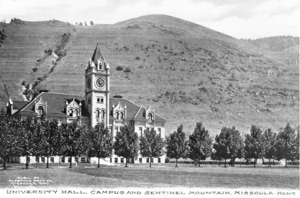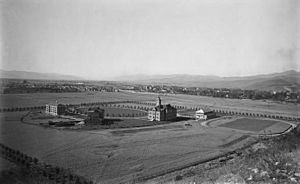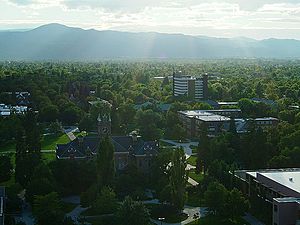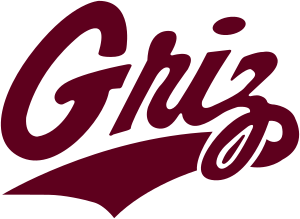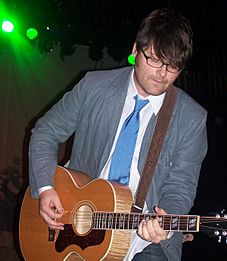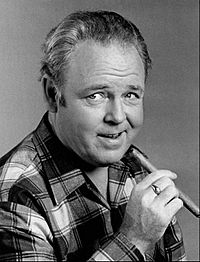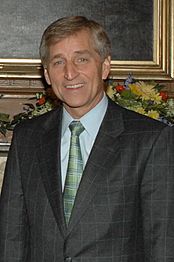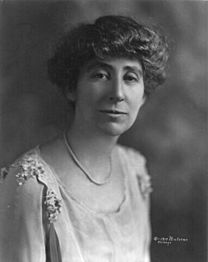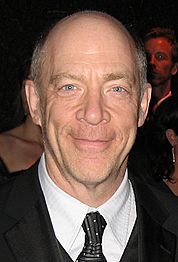University of Montana facts for kids
 |
|
|
Former name
|
Montana State University (1945–1965) |
|---|---|
| Motto | Lux et Veritas (Latin) |
|
Motto in English
|
"Light and Truth" |
| Type | Public research university |
| Established | February 13, 1893 |
|
Parent institution
|
Montana University System - The University of Montana System |
| Accreditation | NWCCU |
|
Academic affiliations
|
Space-grant |
| Endowment | $241.6 million (2022) |
| President | Seth Bodnar |
| Provost | Adrea Lawrence |
|
Academic staff
|
559 full-time, 232 part-time |
| Students | 10,962 (fall 2018) |
| Undergraduates | 6,909 total (fall 2018) |
| Location |
,
,
United States
|
| Campus | Small city, 220 acres (89 ha) |
| Newspaper | Montana Kaimin |
| Colors | Maroon and silver |
| Nickname | Grizzlies and Lady Griz |
|
Sporting affiliations
|
|
| Mascot | Monte |
 |
|
The University of Montana (UM) is a public research university located in Missoula, Montana. It is a very important part of the Montana University System. UM is the second-largest campus in this system. In the fall of 2018, about 10,962 students were studying there. The university is known for its high level of research activity.
The University of Montana has a strong record of students winning national awards. Many students have won Rhodes Scholars, Truman Scholars, Goldwater Scholars, and Udall Scholars. One former student, Harold Urey, even won the Nobel Prize.
Contents
How the University of Montana Started
The idea for the university began on February 18, 1881. The U.S. Congress set aside a large area of land in Montana Territory for a new university.
Montana became a state on November 8, 1889. Soon after, the state government started deciding where the state capital and the new university would be. Leaders in Missoula wanted the university to be in their city. They made a deal with Helena, which was the capital at the time. Missoula agreed not to try to become the new capital. Instead, they supported Helena over Anaconda. This helped Missoula get the university.
Missoula won the vote for the university in February 1893. The university officially opened in 1895. Before the main campus was ready, classes were held at Willard School nearby. Some local families and companies donated land for the new campus. In June 1898, the first stone was laid for University Hall. This building was designed by A.J. Gibson. Missoula then became known as "the University City."
From 1945 to 1965, the university's name was changed to "Montana State University." During this time, the school in Bozeman was called "Montana State College."
Leaders of the University
The university has had many presidents over the years. These leaders help guide the school and its students. You can find a full list of them at Presidents of the University of Montana.
What Students Learn at UM
| ARWU World | 601-700 |
|---|---|
| ARWU National | 155-175 |
| USNWR National University | 254 |
| Washington Monthly National University | 205 |
| Forbes | 610 |
The University of Montana has eleven main colleges and schools. These include:
- College of Humanities & Sciences
- Phyllis J. Washington College of Education and Human Sciences (for teaching and human studies)
- W.A. Franke College of Forestry and Conservation (for studying forests and nature)
- College of Health Professions and Biomedical Sciences
- College of Visual and Performing Arts
- Alexander Blewett III UM School of Law (for law students)
- UM College of Business
- UM School of Journalism
- UM School of Extended and Lifelong Learning
- Missoula College
- Bitterroot College
The College of Education and Human Sciences has five departments. It also has a research center. The School of Law became a member of a national law school group in 1914. It was approved by the American Bar Association in 1923. The College of Forestry offers many programs. Students can study things like Ecosystem Science, Forestry, and Wildlife Biology. They can also earn advanced degrees.
How to Get Into UM
In the fall of 2017, about 6,182 students applied to the University of Montana. Most of them, 93%, were accepted. The students who started that year had good grades in high school. Their average GPA was 3.55. Their test scores on the SAT and ACT were also strong.
Exploring the University Campus
The first plan for the campus was made by Professor Frederich Scheuch. He wanted a central oval area with all buildings facing it. This would create a pattern like rays from the center. Over time, the campus grew with different building styles. Many buildings have three stories and green roof tiles.
Today, the campus covers about 220 acres. It is next to Mount Sentinel on the east and the Clark Fork River on the north. There are 64 buildings on the main campus. This includes nine dorms where students live. There are also sports venues like Washington–Grizzly Stadium, a large football stadium. The Adams Center is a big arena where the university's basketball teams play.
Here are some famous spots on campus:
- The Oval
This is a 3-acre grassy area in the middle of the university. It used to be a solid lawn where students were not allowed to walk. Now, it has brick paths. Trees were planted around the Oval in 1896. A bronze grizzly bear statue stands at the west end of the Oval. It was made by Rudy Autio in 1969. The statue is 7 feet tall and weighs 5,000 pounds. Many photos of the university show the bear with the Oval and Mount Sentinel's 'M' in the background.
- The "M" Trail
This is a 3/4-mile trail that goes up Mount Sentinel. It has 13 turns and climbs 620 feet. From the top, you can see amazing views of Missoula.
People aren't sure exactly when the "M" was first put on Mount Sentinel. Around 1908, students made a zigzag trail up the mountain. They carried stones to form the "M" symbol. The first "M" was small and made of whitewashed rocks. It was replaced by a wooden "M" in 1912. A bigger wooden "M" was built in 1913. Each year, new students were in charge of keeping it in good shape.
In 1915, a snowstorm destroyed the large wooden "M." An even bigger "M" was then built using whitewashed granite. The tradition of freshmen keeping the "M" clean continued for many years. However, in 1968, a concrete "M" was built. This made it easier to maintain. Even though the annual whitewashing stopped, a tradition of lighting the "M" continues. Every fall, during the university's Homecoming celebration, special lights make the "M" glow. This welcomes former students back to campus.
- Memorial Row
On the north side of campus, 29 evergreen trees stand in two lines. This area is called Memorial Row. The trees were planted in 1919 after World War I. They honor UM students, alumni, and teachers who died in the war. Some died in combat, and many more died from the influenza epidemic. The trees are Ponderosa Pines, which are the state tree of Montana. There are also brass plaques with the names of those honored.
Other interesting places on campus include:
- Maureen and Mike Mansfield Library
- Philip L. Wright Zoological Museum
- Washington–Grizzly Stadium
- spectrUM Discovery Area
How the University is Run
University Leadership
The University of Montana is the main campus for a larger university system. This system includes four other campuses. Montana has two public university systems. Both are managed by the Montana Board of Regents. This board has seven members chosen by the state governor. The governor and the Superintendent of Public Instruction are also part of the board.
The Board of Regents chooses the university president. The president is in charge of the university and reports to the Commissioner of Higher Education.
How the University Gets Money
In 2017, the University of Montana's total budget was about $423 million. This money comes from different sources. For example, about $149 million came from general funds.
Over the last 30 years, the state has given less money to higher education. In 1990, the state paid for 69% of the university's main budget. Now, it pays for only 33%. To make up for this, the university has gotten more money for research projects. This funding grew from $12 million in 1994 to $88 million in 2017.
Colleges and Schools at UM
The University of Montana has seven colleges and two special schools:
- College of Humanities and Sciences (started 1893)
- Phyllis J. Washington College of Education and Human Sciences (started 2009)
- W.A. Franke College of Forestry and Conservation (started 1913)
- College of Health Professions and Biomedical Sciences, which includes:
- Skaggs School of Pharmacy (started 1907)
- School of Physical Therapy and Rehabilitation Science
- School of Social Work
- School of Public and Community Health Sciences
- Missoula College (started 1956), which includes:
- College of Technology
- Bitterroot College (in Hamilton, MT)
- College of the Arts and Media, which includes:
- School of Art
- School of Theatre and Dance
- School of Media Arts
- School of Music (started 1893)
- School of Journalism (started 1914)
- Davidson Honors College (started 1991)
- College of Business (started 1918)
- School of Law (started 1911)
The university also has many other projects, research centers, and institutes.
University News and Media
The Montana Kaimin is the student-run newspaper. It started in 1898 and is independent from the university. The Montanan is the university's magazine for former students. CutBank is a literary magazine started by the Creative Writing Program. Camas: The Nature of the West is another literary journal run by graduate students.
KBGA (89.9 FM) is the college radio station. KUFM-FM is the main station for Montana Public Radio. It started in 1965. KUFM-TV (Channel 11) is the local Montana PBS television station.
Student Life at UM
| Race and ethnicity | Total | ||
|---|---|---|---|
| White | 76% |
|
|
| Other | 10% |
|
|
| Hispanic | 6% |
|
|
| Native American | 5% |
|
|
| Asian | 1% |
|
|
| Foreign national | 1% |
|
|
| Black | 1% |
|
|
| Economic diversity | |||
| Low-income | 35% |
|
|
| Affluent | 65% |
|
|
There are many student groups on campus. Seven fraternities (for men) and four sororities (for women) have groups at UM. These include Phi Delta Theta, Sigma Nu, Sigma Chi, Sigma Phi Epsilon, Sigma Alpha Epsilon, Kappa Sigma, Kappa Alpha Theta, Kappa Kappa Gamma, Delta Gamma, and Alpha Phi.
The University of Montana's International Program started in 1924. It was founded by Alex Stepanzoff and four other Russians. They were the first foreign exchange students at the university. This makes it the oldest student group at UM. The first study abroad programs began in 1971. Students could study in France, Germany, and Spain. By 2010, the university had partnerships with over 90 universities in more than 40 countries.
Programs about Central and Southwest Asia started in 1997. UM is the only American university that offers a special degree in this area. In 2010, a center for studying Central and Southwest Asia was created at the university.
Getting Around Campus
- If you want to park on campus, you need a parking permit or a guest pass. This is needed Monday through Friday, from 7 AM to 5 PM. Some parking spots are reserved for specific people. Day passes for visitors cost $3.50. You can buy them at several places on campus.
- Students can buy a full-year parking pass for $232.
- Since January 2015, all Mountain Lines buses are free for everyone. You can reach the university using the Mountain Line bus system on routes 1, 8, and 12. Buses do not run on Sundays.
- The university has two Park and Ride lots. These are located north and south of the main campus. Shuttles run from these lots to the Missoula College, Main Campus, and student housing. They run every 10–20 minutes on weekdays during the school year.
- UDASH is a late-night shuttle service. It runs every half hour from campus to student housing and downtown.
- The ASUM Cruiser Co-op program lets students borrow yellow cruiser bikes for free. You can check out a bike for up to two days with your student ID card.
University Sports Teams
The university's sports teams are called the Montana Grizzlies. They are often called Griz or Lady Griz. The Lady Griz name is mostly used for the women's basketball team. All other women's teams are just called the Griz. The university has been part of the NCAA's Big Sky Conference since 1963. Before that, from 1924 to 1950, UM was part of the Pacific Coast Conference. The University of Montana has a big rivalry with Montana State University. Their football games are known as the "Brawl of the Wild."
Here are some of their sports programs:
- Montana Grizzlies football – Since the 1990s, the Griz football team has been very strong. They have won national titles in 1995 and 2001.
- Montana Grizzlies men's basketball – The men's basketball team has also been successful. They have played in the NCAA Division I Men's basketball tournament many times. In 2006, they won a game in the tournament for the first time in 31 years.
- Montana Grizzlies women's basketball – The women's basketball team is the most successful team in the Big Sky Conference. They have won 17 conference titles. They have also played in the NCAA Women's tournament 17 times. Robin Selvig coached the Lady Griz from 1978 to 2016. He won 865 games, which is one of the most wins for any women's basketball coach.
Other sports include cross country, golf, track and field, tennis, volleyball, and soccer. In 2015, UM added women's softball.
Students can also join many intramural sports clubs. These include men's and women's lacrosse, ski team, rowing, dance, cheer, ice hockey, men's soccer, and rugby.
The university's mascot is Monte, a Grizzly Bear. In 1897, a real bear cub traveled with the football team. The team was then called the "Bears." The name "Grizzlies" was adopted in 1923. Monte, the costumed mascot, was created in 1993. He is known for his fun tricks like break-dancing and back-flipping. Monte has even won awards as the National Champion Mascot of the Year.
Famous People from the University of Montana
-
Carroll O'Connor
Actor -
Jeannette Rankin
First woman elected to the U.S. House of Representatives -
J. K. Simmons
Actor
Many talented people have studied or worked at the University of Montana. They have become successful in sports, entertainment, government, and science.
Athletes
- Aldo Forte, NFL football player
- Brian Salonen, NFL football player
- Chase Reynolds, NFL football player
- Colt Anderson, NFL football player
- Dan Carpenter, NFL football player
- Dave Dickenson, Canadian football player
- Doug Betters, NFL football player
- Josh Barnett, former UFC Heavyweight Champion
- Kroy Biermann, NFL football player
- Larry Krystkowiak, former NBA player and coach
- Lex Hilliard, NFL football player
- Marc Mariani, NFL football player
- Micheal Ray Richardson, NBA player
- Robin Selvig, famous basketball coach for the Lady Griz
- Scott Gragg, NFL football player
- Tim Hauck, NFL football player
- Wayne Tinkle, former basketball player and coach
Entertainment and the Arts
- Lily Gladstone, actress
- Carroll O'Connor, actor, known for All in the Family
- Colin Meloy, lead singer of The Decemberists
- Eric Braeden, actor, known for The Young and the Restless
- J. K. Simmons, Oscar-winning actor
- Jeff Ament, founding member of Pearl Jam
- Susan Gibson, songwriter for "Wide Open Spaces"
Law, Politics, and Government
- Forrest H. Anderson, former Governor of Montana
- Jeannette Rankin, first woman elected to the U.S. Congress
- Jim Messina, political staffer for President Barack Obama
- Mike Mansfield, U.S. Senator and Senate Majority Leader
- Ted Schwinden, former Governor of Montana
Science and Academia
- Emily Graslie, host of YouTube channel The Brain Scoop
- Harold Urey, Nobel Prize winner for his work on isotopes
- Steve Running, expert in global ecosystem monitoring
Writers
- A.B. Guthrie Jr., Pulitzer Prize-winning author
- Allie Brosh, blogger and author
- Andrew Sean Greer, Pulitzer Prize winner for his novel Less
- James Welch, award-winning author
- Shannon Hale, young adult fantasy author
- William Finnegan, Pulitzer Prize winner for his memoir
See also
 In Spanish: Universidad de Montana para niños
In Spanish: Universidad de Montana para niños
- List of forestry universities and colleges
- University of Montana Grizzly Marching Band


